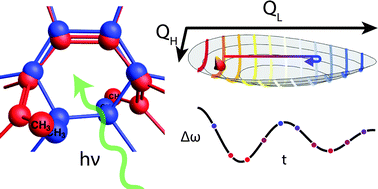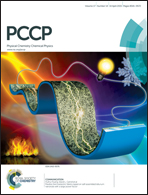Reactive and unreactive pathways in a photochemical ring opening reaction from 2D femtosecond stimulated Raman†
Abstract
Two-dimensional femtosecond stimulated Raman spectroscopy (2D-FSRS) is used to probe the structural evolution of a modified cyclohexadiene as it undergoes a photoinduced ring opening reaction. Analysis of the excited state stimulated Raman vibrational data reveals oscillations of the center frequencies and amplitudes of 21 high frequency modes. These oscillations in vibrational properties are due to anharmonic couplings between the high frequency finger print modes and the impulsively driven low frequency molecular distortions in the excited state. The largest anharmonic couplings, with intrinsic oscillation magnitudes of up to 40 cm−1, are observed between the 467 cm−1 C–C bend and the 1333 cm−1 C–C stretch with the 191 cm−1 methyl wag, all of which are centered on the reactive cyclohexadiene moiety. Conversely, motions located on the periphery – the 993 cm−1 phenyl bend, the 1389 cm−1 methyl bend and 1580 cm−1 phenyl C–C stretch – are coupled with the 104 cm−1 asymmetric bend. These couplings reveal two key energetic pathways: one leading to formation of the ring-opened product and the other reversion back to the ground state. This work is also important because it presents a new powerful method for measuring anharmonicities of potential energy surfaces and determining their role in chemical reactivity.



 Please wait while we load your content...
Please wait while we load your content...